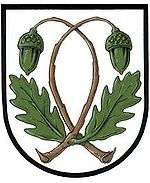Pouzdřany
Pouzdřany (German: Pausram) is a township in Břeclav District in the South Moravian Region of the Czech Republic, 13 km west of Hustopeče.

Geography
Pouzdřany lies on the left bank of the river Svratka in the valley of Thaya-Schwarza. To the south are the Thaya reservoirs of Nové Mlýny. Neighbouring towns are Vranovice and Uherčice to the north, Starovice and Popice to the east, Strachotín to the south-east, Pasohlávky to the south-west, Ivaň to the west and Přibice to the north-west.
History

Pausram was first mentioned in 1244. Because of the lack of an heir, the town returned to the Emperor in 1556. He allowed four farmer’s markets to be held and the demand of the payment of tolls. In 1593 Pausram received a regulation for the vineyards. In the middle of the 16th century the Anabaptists settled in the town. So the parish became Protestant until during the Thirty years war all non-Catholics were expelled from the town. During the following wars against the Turks Pausram was totally burnt down and looted in 1663. In the years of 1832, 1848 and 1866 the cholera raged in three waves and caused a total of 218 victims in the town. In 1869 a railway station was built in Pausram for the railway line that had existed since 1839. In the years 1928/29 a school for the Czech minority was built. During the time between 1932 and 1935 there was big unemployment, which was provisionally overcome by emergency work like paving roads or planting trees. Parish registers have existed since 1630 and land registration since 1687.
The oldest seal originates from 1581, when the town was given market status. A big recessed renaissance shield shows two oak branches with a leaf and an acorn on each of it. In World War I 35 men of the town fell.
After World War I the multi-ethnic state Austria-Hungary was split up. By the Treaty of Saint-Germain-en-Laye Pausram became part of the new Czechoslovakian Republic. Following the Munich Agreement German troops marched into the town in October 1938. From that time onward the town belonged to the Gau Niederdonau until 1945. During the war 68 inhabitants fell or remained missing. On April 16, 1945, Soviet troops invaded Pausram; four days later on April 20, 1945 Czech squatters were brought into town. The remaining German men were detained and the women and children were taken inland for compulsory labour. In this time there were four civilian victims. After the end of World War II the town fell back to Czechoslovakia. As a result of the Beneš decrees the expropriation without any compensation and the expulsion of the remaining people to Germany was carried out. The town was recolonized because there were only 28 inhabitants left. In 1996 the expelled persons of Pausram repaired the damaged roof of the church and renovated the chapel of St. Rosalia and the War Memorial.
Population development
| Census year | Population | Ethnicity of inhabitants | ||
| year | German | Czechs | other | |
| 1793 | 820 | - | - | - |
| 1836 | 1029 | - | - | - |
| 1869 | 1235 | - | - | - |
| 1880 | 1236 | 1229 | 2 | 5 |
| 1890 | 1296 | 1149 | 140 | 7 |
| 1900 | 1218 | 1182 | 28 | 8 |
| 1910 | 1213 | 1173 | 33 | 7 |
| 1921 | 1143 | 903 | 226 | 14 |
| 1930 | 1184 | 863 | 303 | 18 |
References
- German literature:
- Franz Politzky: Ortsgeschichte von Pausram. 1936
- Alfred Schickel, Gerald Frodl: Geschichte Südmährens, Bd.3, 2001, Pausram: Seite 213, 423, 424
- Gerald Frodl, Walfried Blaschka: Kreis Nikolsburg von A–Z, 2006, Pausram: Seite 160
- Bruno Kaukal: Wappen und Siegel 1992, Pausram S. 179
- Erich Mayer: Heimat Pausram. 2004
Document
- Historický místopis Moravy a Slezska v letech 1848–1960, sv.9. 1984
| Wikimedia Commons has media related to Pouzdřany. |